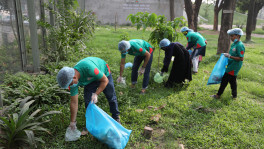The Padma in Rajshahi too in clutches of pollution
If immediate action is not taken against river pollution, the livelihood of the people of the Barind Tract will be severely impacted

Highlights
- Solid and liquid waste dumped into the Padma and along city protection dam
- Several illegal installations along the embankment
- Liquid waste also flows into the Padma through five sluice gates
- Uninhabitable living conditions for people along the river
- Biodiversity of the Padma will also be destroyed
- City protection dam will be weakened and Rajshahi city in its entirety will be at risk
- City corporation garbage vans do not visit regularly
- The Ganges is the second-most polluted river in India
- Thousands of cities, factories, visitors and places of pilgrimage on both sides of the Ganges in India, continuously polluting the river
- Dolphins no longer found in the river
- Number of fish also greatly reduced
- Usage of river water for agriculture also pose increased health risks
Like many rivers in the country, the River Padma in Rajshahi has also fallen prey to illegal grabbing and pollution, as both solid and liquid waste is dumped indiscriminately into the river, posing a long-term threat of water and agricultural land pollution and river erosion.
Solid waste such as broken tiles of houses, discarded pieces of concrete, etc are dumped on the banks. An intention to occupy the river clearly underlies the dumping of such solid waste, which is more evident along the town protection embankment where several illegal installations have already been made.
Researchers on the river have expressed concern that if the river pollution and encroachment are not stopped now, it will have an adverse impact on the livelihoods of the people of the Barind Tract.
Not only will uninhabitable living conditions be created for the people along the river, the biodiversity of the River Padma will also be destroyed. If this pollution continues in the long run, the city protection dam will be weakened and Rajshahi city in its entirety will be at risk.
During visits to the areas adjacent to the river and the embankment, household waste from the surrounding areas was found being dumped in the river, particularly in Bulanpur, Keshabpur, Srirampur, Kumarpara, Sekher Chowk, Panchabati, Talaimari and Shampur areas.
Besides, several restaurants have been set up at various places of the city, including Pathanpara, Dargarapara, Barakuthi and Srirampur. All types of plastic and polythene, and waste from these restaurants are dumped directly into the river.
In addition, liquid waste also flows into the Padma through five sluice gates of the city.
A woman named Runa Akhter, who was dumping garbage in the river near Kumarpara, said everyone in the neighbourhood dumps garbage into the river.

Complaining against the city corporation, Subasi Das from the city's Kumarpara said the city corporation's garbage van sometimes arrives in the evening, sometimes after 8 pm, and sometimes the van cannot be found. Since city corporation vans do not enter the alley, all the garbage of the houses is dumped into the river.
Sheikh Mohammad Mamun, the chief cleaning officer of Rajshahi City Corporation, said, "City corporation vans are supposed to go to the area adjacent to the riverbank. I have to talk to the ward councillors to know if the vans go to those areas."
Garbage was also dumped indiscriminately into the T-dam in front of Keshabpur Police Line. Plastic cups, bottles and polythene can be seen lying across the dam.
Golam Rasul has been running a pan-bidi shop on this dam for 10 years. He said, "Waste has been dumped in the Padma for a long time. Earlier, the city corporation used to periodically clean up the waste, but they have not come for six months."
Waste has been dumped in the Padma for a long time. Earlier, the city corporation used to periodically clean up the waste, but they have not come for six months
Professor Chowdhury Sarwar Jahan of the Department of Geology and Mineralogy, Rajshahi University said the liquid waste that flows into the river through the sluice gate from within the city has more harmful elements in the Dargapara area. As a result, water pollution of the Padma is increasing, threatening aquatic biodiversity in the river.
Liquid waste has already destroyed the aquatic biodiversity of Baranai, another river in the city, he added.
Mizanur Rahman, chairman of Save the Nature and Live, said, "Plastic waste and polythene bags are the most harmful for the River Padma. We are not seeing any benefits from the campaign to reduce the use of polythene."
However, the pollution of the Padma is not only happening in Rajshahi, but the pollution has begun from the source. The River Ganges in India enters Bangladesh and is known as the River Padma up to Goalanda.
According to a study by the Uttar Pradesh Pollution Control Board, the Ganges is the second-most polluted river in India, whereas the river Jamuna is the fifth. There are thousands of cities, factories, visitors and places of pilgrimage on both sides of the Ganges in India, which continuously pollute the river.
However, Professor Tripathi, chairperson of the Mahamana Malivia Research Centre for the Ganges at the Hindu Benares University in India, said the Ganges pollution reduced by 25-30% during Covid-19 pandemic.
Professor Mizanoor Rahman of Geography and Environmental Science at Rajshahi University, said, "A few years ago, I studied the liquid waste of the city corporation going through the sluice gate of the Water Development Board in the River Padma and found a huge level of pollution."
And it is growing. Dolphins are no longer seen as before. The number of fish has also greatly decreased. Besides, the use of river water for agriculture is also posing health risks, since research has shown the water of the Padma has been found to contain metals, he added.
Various institutions and factories should have effluent treatment plants, which are not available in Rajshahi, he said further.
On the other hand, there are 20,000-25,000 registered and unregistered easy bikes in the city. Garages of these easy bikes dump acid from their batteries into sewage drains that lead into the River Padma, which are toxic for all aquatic organisms, he added.
The liquid waste of the city corporation flows into the Padma through five sluice gates. However, when the water level rises during the monsoon, the gates are closed, preventing water from entering the city
Asif Ahmed, a sub-divisional engineer of Rajshahi Water Development Board, said the liquid waste of the city corporation flows into the Padma through five sluice gates. However, when the water level rises during the monsoon, the gates are closed, preventing water from entering the city.
The highest occupation of the town protection dam is observed from Bulanpur to Shampur in Rajshahi City Corporation area.
The Border Guard Bangladesh (BGB) has set up two large installations at the border, called Shimante Abokash (vacation at the border) and Shimante Nongor (anchor at the border) by occupying a large area of the Padma near the city protection dam in the city's Sri Rampur area.
There is a booming restaurant business here and the area is also the site for a permanent conference centre.

However, Asif Ahmed said the dam was not built by land acquisition when the city protection dam was built during the British rule. So, the land next to the dam is considered as khas land, which is owned by the Deputy Commissioner. The BGB is running their restaurant business on a lease from the Deputy Commissioner.
Nazrul Islam, additional deputy commissioner (revenue) of Rajshahi District Administration, said no land of city protection dam has been leased to anyone, however, a case is pending in the High Court over the location of the dam from Srirampur T-Dam to Shimla Park. The High Court has given a status quo in that case.
Meanwhile, Lalon Shah Park has been set up by the City Corporation on the banks of the river near the Pathanpara town protection dam. In one portion, the local people of Pathanpara and Dargapara are tending cattle in temporary cowsheds.
20-25 shops have also been set up along the banks of the Padma on the land adjacent to Barakuthi area. The Awami League has several ward offices with temporary shops.
No solid or liquid waste should be dumped into the river. This is prohibited by law, because liquid waste mixes with water to create a deficiency of biological oxygen, which kills aquatic animals
Golam Sabbir Sattar Tapu, professor of geology and mining at Rajshahi University, said no solid or liquid waste should be dumped into the river. This is prohibited by law, because liquid waste mixes with water to create a deficiency of biological oxygen, which kills aquatic animals.
Dumping of solid waste or building of settlements on and/or along the riverbanks weakens the banks. This also applies to city protection dams. In Rajshahi, there are settlements in the vicinity of the dam, which pose a threat to the city protection dam, and which must be removed, he added.
He said Rajshahi city is two metres below the dam, so it is critically important to protect the latter.


 Keep updated, follow The Business Standard's Google news channel
Keep updated, follow The Business Standard's Google news channel
















